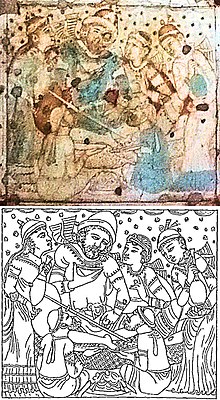Vakataka dynasty
Gupta Emperor Chandragupta II married his daughter into the Vakataka royal family and, with their support, annexed Gujarat from the Saka Satraps in 4th century CE.The rock-cut Buddhist viharas and chaityas of Ajanta Caves (a UNESCO World Heritage Site) were built under the patronage of Vakataka king, Harishena.It appears from the Puranas that Vindhyasakti was a ruler of Vidisha (in the present day Madhya Pradesh state) but that is not considered to be correct.He carried his arms to the Narmada in the north and annexed the kingdom of Purika which was being ruled by a king named Sisuka.In any case, he certainly ruled from Bundelkhand in the north (though Dr Mirashi does not accept that he has crossed the Narmada) to the present Andhra Pradesh in the south.He was a follower of Vedic religion and performed several Yajnas (sacrifices) which include Agnishtoma, Aptoryama, Ukthya, Shodasin, Atiratra, Vajapeya, Brihaspatisava, Sadyaskra and four Asvamedhas.He married his son Gautamiputra to a daughter of King Bhavanaga of the powerful Bharashiva family, which might have proved to be helpful.This is now confirmed by the Kevala-Narasimha inscriptions of Ramtek, where it is announced that (Cā)mundā, a daughter of Queen Prabhavatigupta was given in marriage to the Prince Ghatotkachagupta (who was likely a son of Chandragupta II).The highest number of so far discovered copperplate inscriptions of the Vakataka dynasty (in all 17) pertain to Pravarasena II.See: Shreenand L. Bapat, A Second Jamb (Khandvi) Copperplate Grant of Vakataka Ruler Pravarasena II (Shravana Shuddha 13, Regnal Year 21), Annals of the Bhandarkar Oriental Research Institute, Vol.1–31 Pravarasena II was succeeded by Narendrasena (440–460), under whom the Vakataka influence spread to some central Indian states.He was Defeated by Vishnukundina King Madhava Varma II, After his death in 480, his kingdom was probably annexed by Harishena of the Vatsagulma branch.He is also known as the author of Harivijaya in Prakrit which is based on the story of bringing the parijata tree from heaven by Krishna.He is known from the well-known Washim plates which recorded the grant of a village situated in the northern marga (sub-division) of Nandikata (presently Nanded) in his 37th regnal year.Pravarasena II (c. 400–415) was the next ruler of whom very little is known except from the Cave XVI inscription of Ajanta, which says that he became exalted by his excellent, powerful and liberal rule.The rock cut architectural cell-XVI inscription of Ajanta states that he conquered Avanti (Malwa) in the north, Kosala (Chhattisgarh), Kalinga and Andhra in the east, Lata (Central and Southern Gujarat) and Trikuta (Nasik district) in the west and Kuntala (Southern Maharashtra) in the south.[13][15] Varahadeva, a minister of Harishena and the son of Hastibhoja, excavated the rock-cut vihara of Cave XVI of Ajanta.[13] According to an art historian, Walter M. Spink, all the rock-cut monuments of Ajanta excluding caves nos.According to the eighth ucchvāsaḥ of the Dashakumaracharita of Dandin, which was written probably around 125 years after the fall of the Vakataka dynasty, Harishena's son, though intelligent and accomplished in all arts, neglected the study of the Dandaniti (Political Science) and gave himself up to the enjoyment of pleasures and indulged in all sorts of vices.Finding this a suitable opportunity, the ruler of the neighbouring Ashmaka sent his minister's son to the court of the Vakatakas.[13] This fact is also corroborated by a set of three copper plates of the Davanagere record of the Kadamba king Ravivarma dated 519 CE which state as per historian D. C. Sircar that the king's suzerainty extended over the whole of South India as far as the Narmada river in the north to the Kaveri river near Talakad (the then Western Ganga capital) in the south and that the people of these lands sought his protection.


LICCHAVISVARMANSIKSHVAKUSKALABHRASWESTERNGANGASKADAMBASPALLAVASLITTLEKUSHANSSASANIANHINDKALINGASWESTERNSATRAPSSAMATATASGUPTAEMPIREKIDARITESKUSHANO-SASANIANSSASANIANEMPIREVatsagulmaWashimMaharashtri PrakritSanskritHinduismBuddhismJainismMaharajaVindhyashaktiPravarasena IHarishenaClassical IndiaWestern SatrapsSatavahana dynastyAbhira dynastyKalachuris of MahishmatiVishnukundinaChalukya dynastyRajarsitulyakulaRudrasena IPrithivishena IRudrasena IIPrabhavatiguptaDamodarasenaPravarasena IINarendrasenaPrithivishena IISarvasena IVindhyasenaSarvasena IIDevasenaancient IndianDeccanGujaratTungabhadra RiverArabian SeaChhattisgarhSatavahanasGuptasGupta EmperorChandragupta IISaka SatrapsChalukyas of BadamiDeccan regionviharaschaityasAjanta CavesUNESCO World Heritage SiteVindhyavasiniPuranasK.P. JayaswalV.V. MirashiAmravatiVidishaMadhya PradeshMaharashtraBhavanagaSarvasenaWardha districtNagpur districtNagpurA.S. AltekarChandrapur districtMansarGupta EmpireGaha SattasaiAshoka the GreatMadhava Varma IIWashim districtAjantaparijataheavenNandedALCHONHUNSVISHNU-KUNDINASKALINGAHEPHTHALITESNasik districtviharachaityaGupta dynastySasanianPulakesin IIVakataka DynastyDashakumaracharitaDandinVanavasiNorth Kanara districtDavanagereKadambaD. C. SircarNarmada riverKaveri riverTalakadWestern GangaMarathi peopleMarathaMaharatta tribe or regionS.ChandWayback Machine